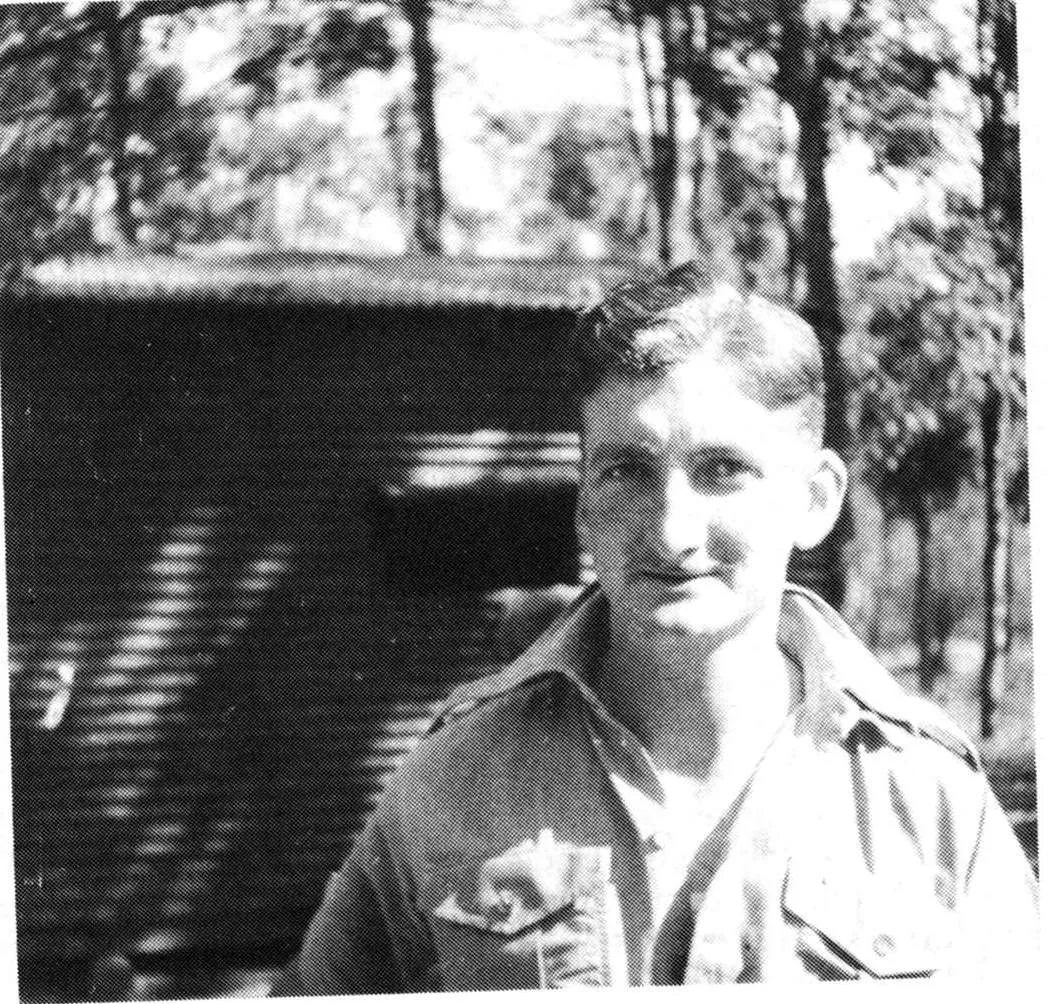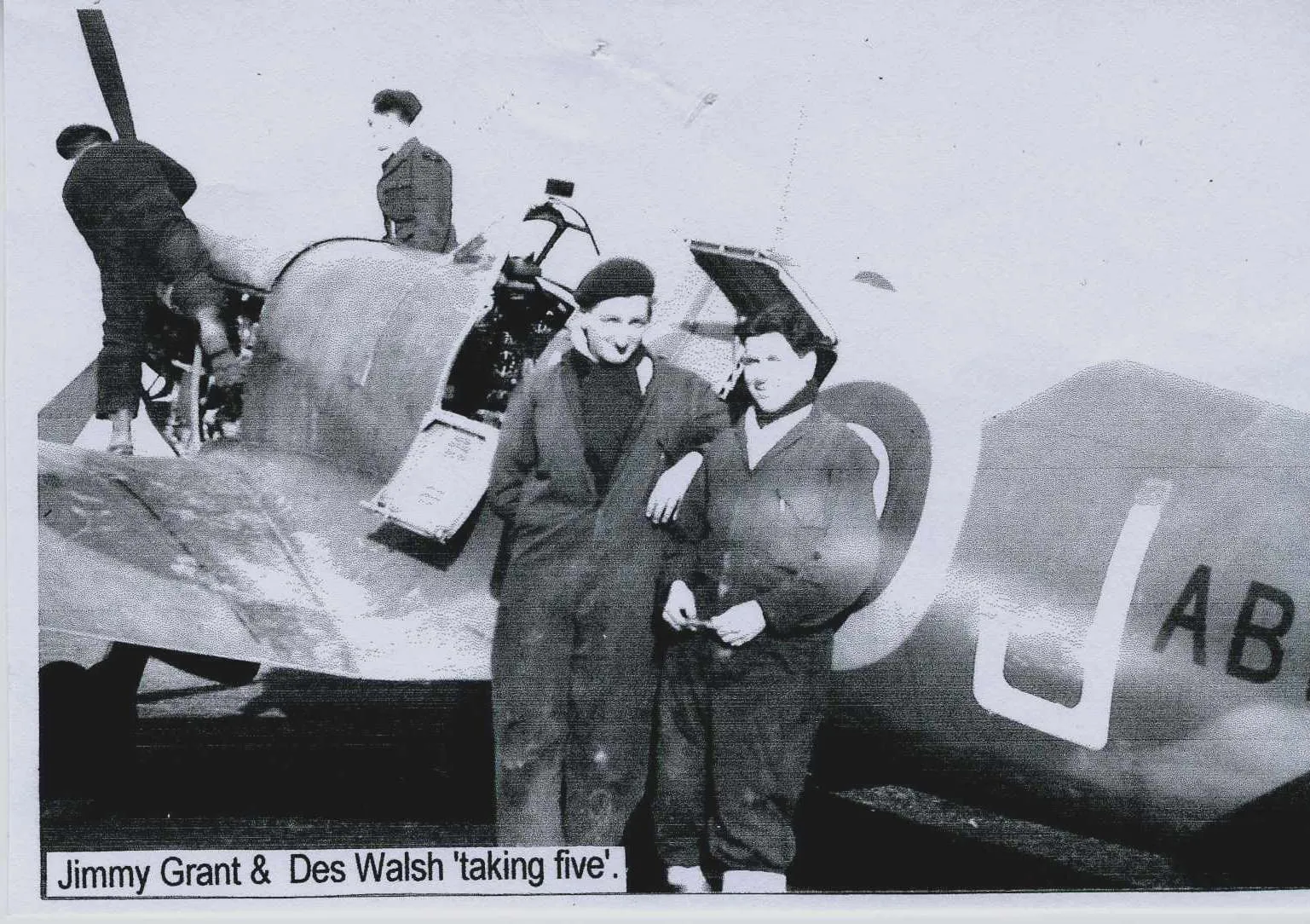SGT James Brodie Grant 15461



| Squadron/s | 457 SQN 74 SQN RAF |
| Rank On Discharge/Death | Sergeant (SGT) |
| Nickname | Jim |
Jim Grant served as a Signalman with 1st. Division Signals from January 1939 (Army Service Number 2658067) until he transferred to the RAAF in June 1940, becoming an Aircraftman Class One Trainee Instrument Maker and began his training at Ascot Vale Melbourne.
When he completed the course, he was in February 1941, posted to No 2 AD Richmond NSW, where with others from his course, to use his own words -- "wasted their time" in the Instrument Repair Section through to May and was promoted to the Rank of Leading Aircraftman, once again to use his own words – "For my war effort", which amounted to making serviceable two Walrus seaplane engine speed indicators, using a third for spare parts.
Jim and his "newcomer" colleagues, formed the opinion that the Permanent Air Force Corporals and other ranks serving on the base, would be quite satisfied to spend the war at RAAF Richmond, but this was not for Jim and his mates, for when the opportunity arose for them to volunteer for the RAF Infiltration Scheme, they did just that and moved on.
Jim was posted to Number 454 Squadron, where its ground crews were assembling at RAAF Williamtown NSW in preparation for a departure to the Middle East, but on 11th. July his posting was cancelled and replaced with another to Number 457 Squadron, which was in the process of forming up under the command of RAF Squadron Leader Peter Brothers DFC, at Baginton in the UK.
After a ten week wait and several "final leaves", Jim’s Draft went aboard the "Awatea" in Darling Harbour Sydney, bound for Vancouver Canada via Auckland NZ and Suva Fiji. On the second leg of the journey, the Canadian National Railway carried the draft across the continent to RCAF "Y" Depot, Halifax Nova Scotia, where it remained until the "Empress of Asia" bore hundreds of Aussies, Kiwis and Canadians across the Atlantic to Liverpool England, which was reached on 28th. September 1941, but then it was up to British Rail to speed the draft on the last leg of the journey to the other side of the world to the RAF Reception Center Bournemouth.
No sooner had they settled in at this attractive Channel Resort town, than small groups of mixed musterings were dispatched to RAF Spitfire squadrons scattered around the UK to "learn the ropes" so to speak. In Jim’s case, he and several others were sent off to Acklington, well to the North on attachment to Number 74 RAF Spitfire Squadron, but on arrival there, they found that this "Battle of Britain" fighter unit had moved to Llanbedr North Wales a day or so earlier, for a well-earned rest from front line duties.
It was here, when they eventually reported in to this RAF Base, that these men learnt how to keep these famous WWII fighters in fighting trim and it was eight weeks before they were ready, to go it alone under the watchful eye of senior RAF NCOs on Number 457 Squadron RAAF, when they rejoined their outfit, then based at Kirk Andreas on the Isle of Man, working up the unit for its part in "The Battle for Europe".
During this period, RAAF pilots arrived from their Operational Training Units to join the nucleus of experienced RAF fighter pilots and a host of RAF ground staff were posted in to make up the required numbers of an operational squadron and it was at this time, 1st. January 1942 to be precise, that Jim made it to Temporary Corporal, but it wasn't until May, when the Squadron was about to return to Australia, that he became aware of the promotion, due probably to the fact the Poms had no establishment for Instrument Makers. Instrument Repairers, yes, so the "powers that be" must have consigned the matter of Jim's pay to the "Impossible" basket.
On March 22nd. 1942, Number 457 Squadron moved to Redhill Aerodrome, South Nutfield Surrey, where Number 452 Squadron RAAF, the first Australian Spitfire Squadron to be formed in the UK, had spent a very successful 10 months with Number 11 Group, in action over enemy held territory.
For 457 Squadron, it was a hectic experience and for most, it was their first exposure to pilots being sent over enemy territory and not returning, however everyone learned to cope and put to good use the skills both pilots and ground crews had acquired. The ten weeks of frontline action ended at the end of May 1942, when the Squadron was stood down in preparation for a return to Australia, in company with Number 52 Squadron and Number 54 Squadron RAF, to form Number 1 Fighter Wing RAAF and engage the Japanese Air Forces that had been attacking targets in Northern Australia, from nearby occupied Timor, since their demolition of Pearl Harbor Hawaii in December 1941.
The entire Wing went aboard the "Stirling Castle" docked at Liverpool and arrived in Melbourne via Freetown Sierra Leone and Durbin South Africa on 13th August 1942 and after some disembarkation leave in his home state, Jim reported back to his Squadron, now under the command of Squadron Leader Ken James and based at RAAF Richmond NSW, awaiting the assembly and delivery of its Vc Spitfires and the orders to proceed to the Darwin Area. Jim's "A" Flight, denied the convenience of Richmond Base proper, had been shunted off to Yarramundi and living under canvas.
The six aircraft that had arrived from the UK aboard the "Stirling Castle", were delivered in crates to Richmond and assembled there in September but the squadron's full complement of aircraft did not materialise until October after the squadron had moved to Camden and when they were eventually flown in, the ground crews gave them a really good going over and the pilots air tested them. Jim was promoted to the rank of Sergeant at Camden just before the three Squadrons got on their way to their date with destiny.
For the long journey to Northern Australia, the members of the Wing were divided into three parties. One, the "Land" did it the hard way travelling by rail and truck, another, the "Sea", luxuriated aboard ship and the last to leave, the "Air", made up of the Spitfires their pilots and a Service crew aboard a Hudson bomber.The "Maetsuycker" with Jim aboard, avoided the attention of the Japanese and arrived in Darwin Harbour via Townsville and Thursday Island on 25th. January 1943 and later in the day, after a convoy of Army trucks bore the travellers from the wharf area to Batchelor, well South of the devastated township, they caught up with the overland party which had arrived a day or so earlier and the small airborne service party, which had beaten all the others to the North-West Area. A day or so later, after waiting for the Kittyhawk Squadrons to vacate their strips and camp sites, the Wing moved back up the track in dribs and drabs to occupy Livingston, Strauss and the Darwin Civil strips.
But back to the remainder of Jim's story, we find that some twelve months after his arrival at Livingston Strip, he was sent on detachment to Number 1 Photo Reconnaissance Unit based at Coomalie Creek several miles down the track from Livingston, where he remained for three months, before returning to his home squadron to serve out the remainder of his proscribed time in this forward Operational Area. When his number came up, he was posted to Number 1 AD Laverton Victoria, in June 1944.
Jim worked in the Instrument Section of this Permanent RAAF base, which also acted as a starting point of ferry flights to Operational Units in the South Pacific Area and as the service crews required to maintain the aircraft in the course of the journey were drawn from the ground staff there, Jim made himself available for one of these flights which took him out of the country from August 22nd September 8th 1944.
Then it was back to work in the Instrument Section until on 17th February 1945, he was admitted to Number 6 RAAF Hospital, Heidleburg and later to Number 1 Medical Rehab Unit Warburton, after getting in the way of a .303 bullet which passed through his left knee when an armourer accidently discharged a single round from the machine gun he was removing from the aircraft which the pair were working on, in the course of a routine inspection.
When Jim returned to Laverton at the end of May, he was soon after, posted to RAAF Headquarters at St. Kilda Road Melbourne, where he saw out the War flying a desk and living off the unit at Hawthorn with his wife Jess, whom he had married shortly before his accident. There he filled in his postwar time in the Service awaiting his discharge, which came through on 22nd January 1946.
Back in "Civvy Street", Jim Grant took advantage of the Commonwealth Reconstruction Scheme, becoming a full time student at the Sydney Technical College and graduated from there, as a Licensed Electrician after completing the course.
In 2010, Jim aged 93 years of age and living in full care at Colac in Victoria, chimed in with the final paragraph of this story.
"I draw pleasure and some satisfaction in knowing that in a very small way, I contributed to the making of history".
